The Future of wellbeing
IS RESIDUAL disinfectant
A NEW ERA OF CLEANING AND PUBLIC HEALTH
By Valerie Beck, PhD
TABLE OF CONTENTS
THE DAWN OF ANTIMICROBIAL ERA
Introduction
Dive into the historical journey of disinfectant, its pivotal role in disease prevention, and the emerging innovations that promise to reshape the future of public health by offering enduring protection against pathogens.
THE INVISIBLE WAR
How are Germs Transmitted?
Unearth the subtle mechanisms of germ transmission, from sneezes to surfaces, and comprehend why understanding direct and indirect contact—like droplets, aerosols, and fomites—is essential to fortifying our defense against illnesses.
KNOW THE DIFFERENCE
The Distinction Between Cleaning, Sanitizing, and Disinfecting
Navigate the nuanced differences between these three essential practices, appreciating their distinct roles in our battle against microbes. Discover the gold standards set by leading regulatory bodies and how to tailor practices for diverse environments.
BEYOND TRADITION
Alternatives to Traditional Antimicrobial Practices
Challenge the status quo by delving into the drawbacks of conventional sanitizer and disinfectant. Journey through cutting-edge alternatives, from metal-based coatings to polymer-based solutions, and envision a future with sustained protection against microbial invaders.
DECODING THE REGULATIONS
Types of Residual Antimicrobials and How They Are Regulated
Step into the regulatory world of the US EPA during the COVID-19 pandemic era, unraveling the intricacies of residual antimicrobial categories, their rigorous testing standards, and their impact in real-world scenarios. Arm yourself with the knowledge to differentiate genuine products from the impostors through careful label examinations.
REDEFINING CLEAN
How Will Residual Antimicrobials Change the Way We Clean?
Witness the transformative power of residual antimicrobials as they set new benchmarks in public health, combating germ transmission and antibiotic resistance. Celebrate their potential to bring about financial, time, and health benefits, and embrace the dawn of a safer, cleaner future.
INTRODUCTION
In a world where disease prevention hinges on the battle against invisible microbes, the advent of residual sanitizers to augment traditional disinfection offers a promising and powerful weapon to revolutionize our approach to public health and cleanliness.
Since before World War II, people have relied upon disinfectant to control pathogens and harmful microbes on surfaces. In fact, the battle against organisms represents an essential aspect of public well-being, and surface disinfection approaches remain socially entrenched. Yet even today, pathogenic infections impact an estimated 3 million people in the United States every year. Clearly, the current approach to disinfection is falling short of its promise.
One primary reason is that disinfectant stops working the moment it dries or if wiped away from a surface. Once dry, surfaces are immediately susceptible to recontamination by touch, a nearby cough, or the settling of airborne microorganisms. And this enables the transmission cycle to begin again when someone touches the surface. More frequent cleaning and disinfecting can lessen transmission, but with the trade-off of increased labor, more chemical usage, and inconvenient disruption. For many frequently touched surfaces, like doorknobs and ATM screens, “more frequent cleaning” can be virtually impossible to implement.
In the past few years, new approaches reinvented the technology behind traditional cleaning and disinfecting products. These products provide a strong germ-killing effect while leaving behind an invisible layer of protection to keep surfaces microbe-free between cleaning events. Ultimately, this new class of antimicrobials interrupts the cycle of rapid recontamination in a single application, reducing the consumption of chemicals while achieving their main objective to improve public health and well-being.
SRFC Bio, Inc. is a pioneering biotech enterprise at the forefront of bioscience breakthrough solutions. Based in Dallas, Texas, we’re reshaping the landscape of
well-being and reducing disease transmission with our dynamic portfolio of antimicrobial surface cleaners and coatings.
With over a decade of R&D expertise, we are redefining safety and trust for every surface interaction. Backed by a passionate team of scientists, chemists, and microbiologists, championing the advancement of well-being.
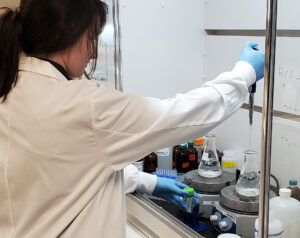
How Germs are Transmitted
Germs are microorganisms that cause illness. And they come in the form of bacteria, viruses, fungi, and protozoa that live in any environment you can imagine. Furthermore, germs spread through both direct and indirect contact.
Direct contact is exactly as it sounds, making physical contact with an infected individual. Alternatively, indirect contact occurs in one of three ways: through droplets, aerosols, or fomites. Of course, droplets and aerosols are common transmission routes for respiratory viruses like the seasonal flu and even SARS-CoV-22. Droplets are larger, heavier particles that usually fall onto nearby surfaces, whereas aerosols are fine particles that can stay suspended in the air for extended periods of time. Droplets and aerosols are generated from infected people when they sneeze, cough, or even speak. Fomites represent inanimate objects on which germs land.
Almost every surface acts as a fomite and can therefore serve as a source of germ transmission. There have been many attempts to understand the specific role that each of these transmission pathways plays in the spread of germs. The complexity of these events has led to insufficient evidence to support one of these mechanisms as the lead contributor to germ transmission.
Download the
Full White Paper
Although there is inconclusive evidence for which factor has the greatest impact on human disease transmission, fomites (surfaces) have long been acknowledged as a contributing factor. The importance of surfaces in transmission originates from the ability of microorganisms to survive and potentially remain infectious for surprisingly long periods of time. Depending on the environmental conditions, bacteria, and viruses can persist on surfaces for months. Additionally, it has been determined through experimentation and observation that surfaces have been the source of infection6,7. It stands to reason that if one of the primary transmission routes for germs can be interrupted, there would be a reduction in illness and infections. Being that surfaces are ubiquitous in the human environment and that aerosols and droplets have a chance to land on and contaminate them, surfaces represent an ideal target for intervention.
THE DISTINCTION
Between cleaning, sanitizing and disinfecting
Cleaning refers to the physical removal of oils, dirt, and dust from surfaces. Cleaners often do not contain ingredients known to kill microorganisms. In contrast, both sanitizer and disinfectant demonstrate some level of microbial kill. Sanitizer and disinfectant are also usually effective cleaners; therefore, these products physically remove oils, dirt, and dust from surfaces and reduce the number of organisms. It is common to refer to these types of sanitizers and disinfectants as “one-step”, meaning that they can both clean and reduce the number of microbes.
Broadly speaking, both sanitizer and disinfectant kill microorganisms, but disinfectants demonstrate a larger reduction in the number of organisms. The United States Environmental Protection Agency (US EPA) regulates sanitizer and disinfectant and therefore defines their performance standards. On hard, non-food contact surfaces, sanitizers must demonstrate a 99.9% reduction against bacteria in 5 minutes8. Put another way, this means that the number of bacteria on a surface reduces from 100,000 to 100. On the other hand, disinfectants must demonstrate a 99.999% reduction against bacteria in 10 minutes, or reduce the bacteria on a hard, non-food contact surface from 100,000 to 19. Additionally, you can evaluate disinfectants for their ability to inactivate viruses; an attribute that will soon extended to sanitizers.
Knowing when it is necessary to implement cleaning, sanitizing, or disinfecting practices is not always straightforward. The type of space and its occupants are critical factors that influence determining the appropriate practice. The Centers for Disease Control and Prevention recommends routine cleaning of frequently touched surfaces with soap and water to remove oils, dirt, and dust.
In most households, cleaning combined with routine sanitization of surfaces is sufficient to reduce the bioburden present in this setting. However, certain circumstances would elevate the requirement for disinfection. For example, if someone in the household is actively sick, surfaces they interact with should be disinfected to reduce the likelihood that other occupants get infected.
In places with large amounts of human traffic (office buildings, entertainment facilities, or schools), cleaning in combination with routine disinfection of communal surfaces may be an appropriate regimen to keep the number of microorganisms present to a minimum. The large number of occupants in these settings leads to increased accumulation of bacteria and viruses on surfaces, necessitating the kill level of a disinfectant.
The healthcare industry has more rigorous cleaning standards than those required in homes or businesses. For instance, hospital systems often implement certain mandated protocols in an effort to mitigate the spread of infections. Disinfection represents the minimum requirement for hard surfaces. So, sanitizers rarely provide sufficient microbial kill to meet healthcare cleaning standards.
ALTERNATIVES
To Traditional Antimicrobial Practices
An inherent property of traditional sanitizer and disinfectant is that they only exert their effect while the surface is wet with the product. Once someone wipes the liquid off the surface or it dries, it no longer kills microbes. To add a layer of complexity, the duration that a surface needs to remain wet with the product to meet sanitization or disinfection criteria is different for each product and ranges from as little as 30 seconds to as long as 10 minutes. This represents the “contact time”. In locations where multiple sanitization or disinfection events are necessary in a single day, adherence to the prescribed contact time leads to repeated exposure to chemicals, increased use of paper and cloth wipes, and significant time and labor commitments. Of course, these drawbacks highlight the need for alternatives to traditional means of sanitization and disinfection.
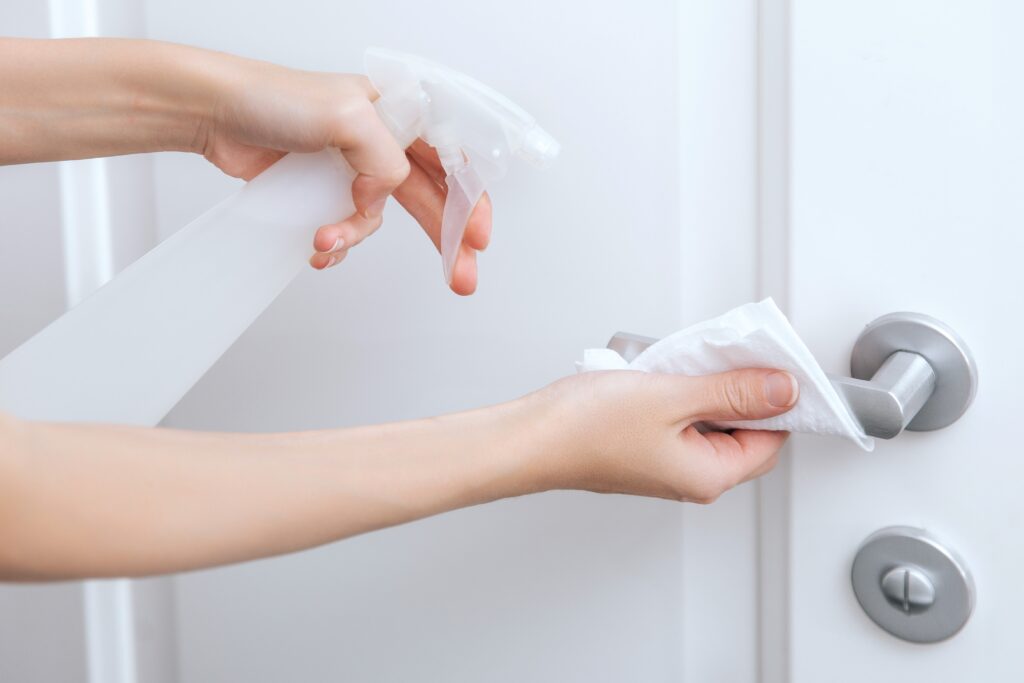
Over the past few decades, there has been a focus on the development of suitable alternatives to traditional sanitization and disinfection. One of the primary goals of these alternatives is to improve upon the key limitations of sanitizer and disinfectant, specifically that they only actively kill microbes on a wet surface. Therefore, the key attribute of these products is that they maintain some level of antimicrobial activity after they have dried, forming a protective coating on the surface. These types of antimicrobial products are generally known as continuously active, long-lasting, persistent, or residual antimicrobial coatings.
Some of the earliest examples of products applying this concept utilized the elements copper and silver. Both metals are inherently antimicrobial and have activity against both bacteria and viruses13. Copper is exceptionally strong and can withstand the normal wear and tear of a heavily used surface while maintaining its antimicrobial properties. Many products, including home appliances, fabrics, toys, and even medical devices, incorporate silver. Although copper and silver fit the criteria of maintaining an antimicrobial effect after drying, they also carry their own limitations. The incorporation of these metals into objects or onto surfaces is not a simple process carried out by the end user. In fact, it usually comes as part of manufacturing.
Additionally, the amount of time (contact time) it takes for these metals to impart their antimicrobial effect is typically longer than that of traditional sanitizer and disinfectant. So, their activity is not as robust as the traditional interventions. Nevertheless, the continuous antimicrobial activity of these metals has proven valuable in healthcare settings13,14.
Switching to residual antimicrobials can have several environmental benefits:
REDUCED CHEMICAL USAGE
As residual antimicrobials remain effective for an extended period, the need for reapplication diminishes significantly, reducing the amount of chemicals released into the environment.
LESS WASTE
Traditional methods often involve the use of single-use wipes or paper towels. Long-lasting antimicrobials can cut down on this waste, contributing to a cleaner planet.
ENERGY SAVINGS
With fewer needs for repeated applications, the labor and time spent on cleaning reduce, saving both human and electrical energy.
Another approach to achieving a long-lasting antimicrobial effect is the incorporation of chemical preservatives into materials. You can integrate these chemicals into a wide variety of materials during the manufacturing process, including but not limited to hardwood floors, doorknobs, fabrics, plastics, and paints. Materials with an embedded chemical preservative are sometimes categorized as treated articles. The chemical preservatives incorporated into treated articles are not as strong as those found in traditional products and only prevent the development of odors and deterioration caused by certain bacteria and fungi. Therefore, you must distinguish between treated articles and the concept of sanitization and disinfection. The article itself is being protected from microbes rather than the surface of that article providing an antimicrobial barrier that can have a positive impact on human health.
More recently, scientists have begun exploring a new strategy to overcome the limitations of the first iterations of long-lasting antimicrobial products. These newer solutions utilize polymer chemistry to create a micro-structure on surfaces that active ingredients stick to, allowing them to persist on the surface when it dries. The first generation of this attempt at a long-lasting antimicrobial is classified as microbiostatic agents. The antimicrobial effect of these products is stronger than treated articles but has limited killing capacity. Microbiostatic products prevent the growth of bacteria as opposed to killing them and cannot market that they provide a public health benefit16. The next generation of long-lasting antimicrobials has built upon the strides that microbiostatic products have made in the industry.
These technologies have optimized polymer systems that incorporate the types of active ingredients commonly found in traditional sanitizer and disinfectant. The inclusion of stronger active ingredients boosts their performance and allows them to state they provide a public health benefit. That is, so long as they meet certain US EPA requirements.
RESIDUAL TECHNOLOGY BY SRFC BIO INC
SRFC Bio utilizes advanced polymer chemistry to create a long-lasting antimicrobial barrier of continuous protection for surfaces* treated with our RS® residual sanitizer. The RS® product cleans surfaces, disinfects bacteria and viruses at application, and keeps killing 99.9% of bacteria for up to 24 hours after it dries.
It’s not enough to just wipe germs away. With our superior, long-lasting, residual antimicrobial technology, we can defend surfaces everywhere, for everyone, all the time.
*Hard, non-porous, non-food contact surfaces
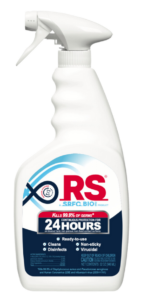
RESIDUAL ANTIMICROBIALS:
The Different Types and How they are Regulated
During the COVID-19 pandemic, the antimicrobial market flooded with many products claiming to provide long-term disinfection. However, only a limited number of these products registered their claims with the US EPA. This further prompted the EPA to issue guidance to stakeholders on the requirements for adding residual claims to EPA-registered products. Currently, the EPA recognizes three categories of residual antimicrobials: residual sanitizers, residual disinfectants, and supplemental residual antimicrobials. The first two categories existed prior to the COVID-19 pandemic, while the last emerged during the pandemic.
The specific testing protocols and performance requirements differ between the three residual antimicrobial categories. However, the key performance metric across all categories is to demonstrate that a product maintains a certain level of antimicrobial activity after physical abrasion. This abrasion regimen represents a simulation of the physical wear and tear a surface would encounter over the duration of the residual efficacy period. A brief description of the performance requirements and real-world application for each category is provided below.
Products that fall under the residual sanitizer category must first meet EPA’s criteria for a traditional sanitizer (99.9% reduction against bacteria within 5 minutes). Then, once a product achieves this criterion, the residual activity is evaluated through a series of alternating wet and dry abrasions paired with multiple contamination events (introduction of bacteria to the test surface between abrasion events). At the conclusion of the durability assessment, the product must again demonstrate a 99.9% reduction against bacteria in 5 minutes. Currently, the EPA limits the duration of residual sanitization claims to 24 hours. And in a real-world scenario, this means that after spraying the product onto a hard, non-food contact surface and it dries, it maintains sanitization-level efficacy against bacteria for 24 hours in just one application.
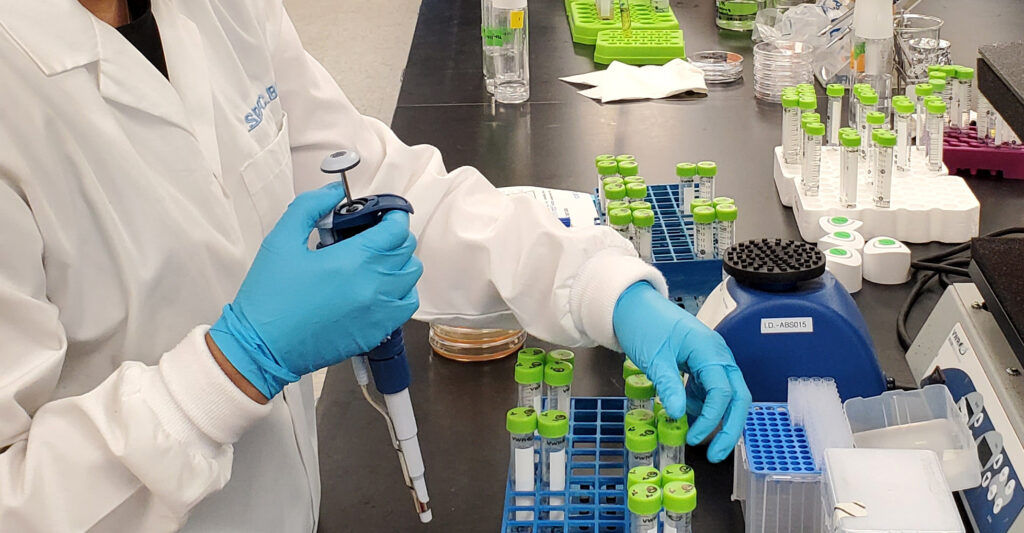
The testing parameters for residual disinfectants are similar to residual sanitizers. However, the performance requirements become harder to achieve for disinfectants, because they require a higher level of kill. Residual disinfectant products must first meet EPA’s criteria for a traditional disinfectant (99.999% reduction against bacteria within 10 minutes). If they achieve this criterion, a residual activity evaluation follows a procedure similar to that used for residual sanitizers. At the conclusion of the durability assessment, the product must again demonstrate a 99.999% reduction against bacteria in 10 minutes.
Unlike residual sanitizers, residual disinfectants can also have residual activity against viruses, provided they have durability data to support the notion. Currently, the duration of residual disinfection claims cannot exceed 24 hours. In practice, this means that after spraying the product onto a hard, non-food contact surface and it dries, it maintains disinfection-level efficacy against bacteria and viruses for 24 hours in just one application.
In the final category of residuals, the testing parameters for supplemental residual antimicrobials differs from residual sanitizers and disinfectants. Abrasions remain a key component of the assessment; however, these products do not have to meet the performance criteria of a traditional sanitizer or disinfectant. This is a key component of the guidance for these products because they represent a supplement to normal disinfection practices. The durability assessment for these products requires that the supplemental residual antimicrobial coatings be exposed to three different disinfectant-level products. At the conclusion of the abrasion procedure, products must demonstrate sanitizer-level efficacy within 2 hours. Like residual disinfectant, supplemental residual products may also show activity against viruses, if they generate appropriate data. The duration of this type of residual claim lasts 7 days. So, with one application, these products retain sanitization-level efficacy for one week and won’t wear off surfaces routinely disinfected.
Although the US EPA standardizes the performance criteria of residual products, it is not always easy to determine the performance level of a product just by reading the label. Some EPA-registered products are marketed for providing a long-term antimicrobial benefit, but these do not fit the definition of residual antimicrobial as defined by EPA. They often belong to the microbiostatic category described above, where they only prevent the growth of bacteria and fungi that can cause malodor and stains and cannot state they provide public health benefits. Therefore, it is important to understand what a specific product can achieve by reading its label. Every product registered with the EPA receives a unique number linked to a document stating the specific efficacy requirements it meets. Searching this product-specific document for keywords like “residual sanitizer” represents an effective way to confirm a product is a legitimate residual antimicrobial.
When it comes to residual antimicrobials, one size does not fit all. The US EPA has established specific categories to help you discern the right product for your needs. Here’s a quick guide to understanding the differences:
RESIDUAL SANITIZER
These products need to show a 99.9% reduction against bacteria within 5 minutes, and they maintain this efficacy for up to 24 hours. They’re subject to testing that includes both wet and dry abrasions to ensure durability. Ideal for everyday settings where high-level disinfection is not critical, but daily sanitization is desired.
RESIDUAL DISINFECTANT
These products need to show a 99.9% reduction against bacteria within 5 minutes, and they maintain this efficacy for up to 24 hours. They’re subject to testing that includes both wet and dry abrasions to ensure durability. Ideal for everyday settings where high-level disinfection is not critical, but daily sanitization is desired.
SUPPLEMENTAL RESIDUAL ANTIMICROBIAL
These are the new kids on the block, primarily established during the COVID-19 pandemic. These products act as a supplement to normal disinfection practices and do not need to meet the same stringent criteria as sanitizer or disinfectant. They maintain sanitizer-level efficacy for up to one week and can withstand routine disinfection processes. Useful in scenarios where extended protection is required but without the necessity for high-level microbial kill.
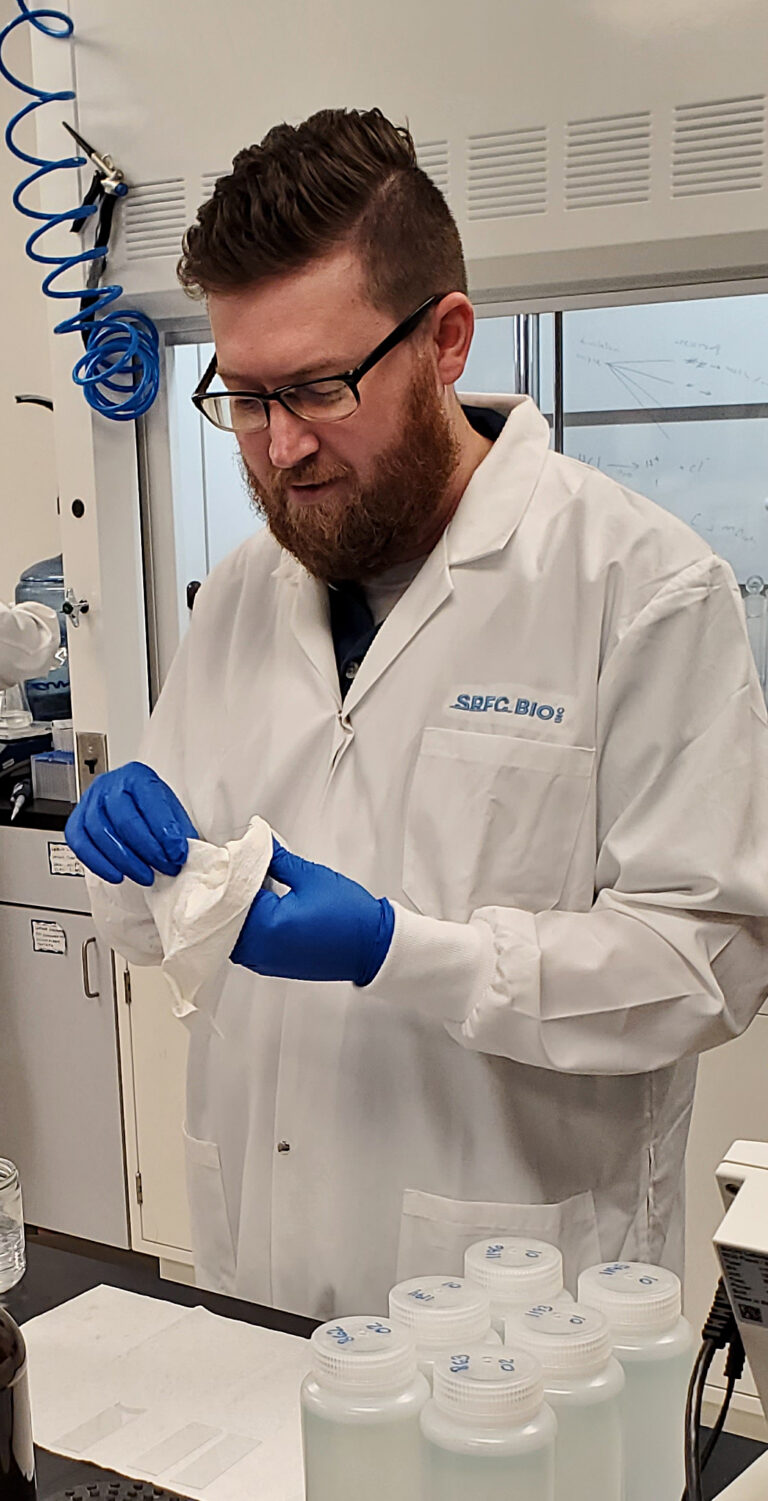
Knowing which category a product falls under helps match the right residual antimicrobial to the needs of your environment. Always remember to refer to EPA guidelines for the most accurate and current information.
RESIDUAL ANTIMICROBIALS
How Will They Change The Way We Clean?
Continuous protection of surfaces against germ transmission is a crucial development for advancing public health and disease prevention. Some of the first-generation residual antimicrobials have been put to the test in clinical settings to ascertain if they actually provide a benefit to public health. Not surprisingly, use of these persistent antimicrobials was associated with a decrease in the number of bacteria isolated from surfaces as well as reduced infection rates in hospitals21, 22.
This evidence highlights the benefit and need for alternative strategies to traditional methods of disinfection that can enhance infection prevention. Next-generation residual antimicrobials meet much higher performance standards than their predecessors. In fact, they’re meant to withstand the wear and tear associated with daily use. These aspects should only increase their potential as worthwhile mechanisms to increase safety through a reduction in surface-based germ transmission.

In addition to the major upside of reducing germ transmission, residual antimicrobials offer substantial financial and time savings. The persistent nature of residual sanitizer and disinfectant allows their application to limit to once a day. During this 24-hour period, occupants of the treated space are assured that those surfaces are actively killing bacteria (or viruses) that happen to land on the surface with just a single application of the product. By transitioning to the use of these products, companies and consumers can significantly reduce costs associated with cleaning chemicals, single-use paper products, and labor while gaining valuable time.
As public health awareness rises, the demand for continuous antimicrobial protection has reached an all-time high. Outdated methods no longer suffice as the standard for maintaining a healthy life and ensuring the well-being of our families and workplaces. This is especially true in the context of antibiotic resistance, where the development of resistance to current pharmaceutical antibiotic therapies significantly outpaces the implementation of new drugs to treat these infections. It is critical that other methods of intervention be deployed to compensate for the limitations of pharmaceuticals. Residual antimicrobials, with their capability to provide long-lasting protection, are poised to become the new standard in cleaning technology, shaping a healthier future for all.
About the Writer
Valerie Beck is the Director of Microbiology at SRFC Bio with 10+ years of experience, having served in multiple research roles. Her expertise lies in mechanisms of antibiotic research in hospital-associated pathogens and the in vitro efficacy of over-the-counter drugs. Valerie holds a B.S. and Ph.D. in Molecular and Cellular Biology from the University of Texas at Dallas. She was inspired to pursue science after a work-study job during college, where she became hooked on research.

At SRFC Bio, Valerie leads the development of innovative and science-backed infection control technology. Her personal mission is to work towards solutions that have a positive impact on society, with a focus on ensuring that technologies claiming to improve human health are rigorously tested. Valerie’s greatest career achievement so far has been contributing to the development of a fully registered antimicrobial product in just over a year.
TAKE THIS WHITE PAPER WITH YOU
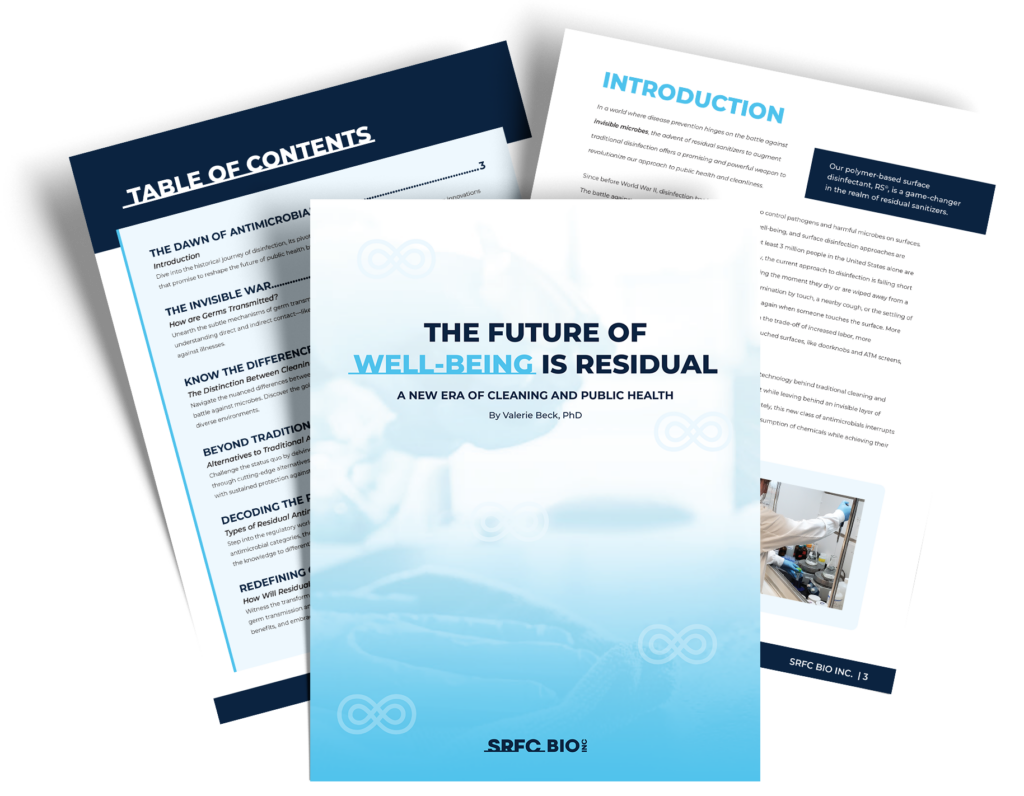
Additional Sources
2. Leung, Nancy HL. “Transmissibility and transmission of respiratory viruses.” Nature Reviews Microbiology 19.8 (2021): 528-545.
6. Mubareka, Samira, et al. “Transmission of influenza virus via aerosols and fomites in the guinea pig model.” The Journal of Infectious Diseases 199.6 (2009): 858-865.
7. Barker, J., D. Stevens, and S. F. Bloomfield. “Spread and prevention of some common viral infections in community facilities and domestic homes.” Journal of Applied Microbiology 91.1 (2001): 7-21.
8. U.S. Environmental Protection Agency, Office of Chemical Safety and Pollution Prevention, Product Performance Test Guidelines, OCSPP 810.2300: Sanitizers for Use on Hard Surfaces – Efficacy Data Recommendations. October 2012.
9. U.S. Environmental Protection Agency, Office of Chemical Safety and Pollution Prevention, Product Performance Test Guidelines, OCSPP 810.2200: Disinfectants for Use on Environmental Surfaces – Guidance for Efficacy Testing. February 2018.
13. Rakowska, Paulina D., et al. “Antiviral surfaces and coatings and their mechanisms of action.” Communications Materials 2.1 (2021): 53.
14. Schmidt, Michael G., et al. “Copper surfaces are associated with significantly lower concentrations of bacteria on selected surfaces within a pediatric intensive care unit.” American Journal of Infection Control 44.2 (2016): 203-209.
16. Calfee, Michael Worth, et al. “Virucidal efficacy of antimicrobial surface coatings against the enveloped bacteriophage 6.” Journal of Applied Microbiology 132.3 (2022): 1813-1824.
21. Schmidt, Michael G., Sarah E. Fairey, and Hubert H. Attaway. “In situ evaluation of a persistent disinfectant provides continuous decontamination within the clinical environment.” American Journal of Infection Control 47.6 (2019): 732-734.
22. Ejerhed, Lars, Leyla Roshani, and Annette Erichsen Andersson. “Antimicrobial coating is associated with significantly lower aerobic colony counts in high-touch areas in an orthopedic ward environment.” Annals of Clinical Microbiology and Antimicrobials 19.1 (2020): 1-7.
Our Technology
RS® Benefits Infographic





© 2024 SRFC Bio Inc. All Rights Reserved.

Please wait while you are redirected to the right page...